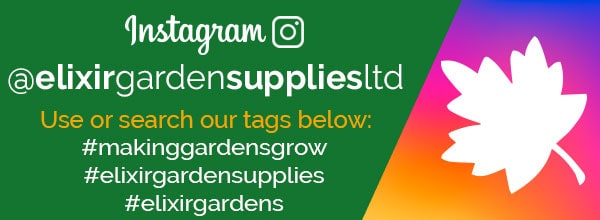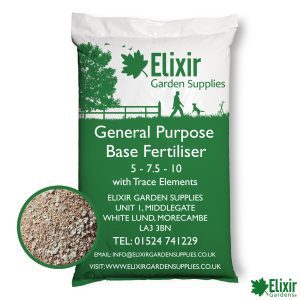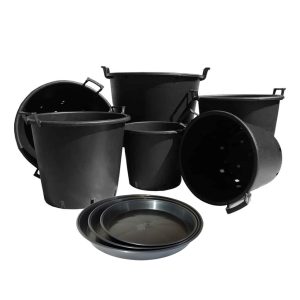Growing Potatoes
with Chris
One of our Elixir Gardens Sponsorship winners has written an amazing article to share with all of our subscribers.
He goes into fine detail on how to grow your own spuds at home, with limited space, using only Elixir Gardens products so you can all try it too!
Check it out below and view all related products at the bottom of the article.
One of the biggest benefits of growing your own potatoes is that you can grow varieties for a range of uses and experience the different tastes that each provide.
You don’t even need a big garden to grow delicious potatoes they can easily be grown in pots, which gets the planting season underway for me in March. I grow eleven different varieties of potatoes and stagger my plantings up until mid-July to provide early and salad potatoes throughout the summer months. This is before the second early and main crop varieties are available from Autumn, to the late spring of the following year.
A crop of first earlies generally take arounds 12 weeks to produce from planting. This I use as a guide to time plantings so we have a continuity of potatoes from the previous seasons crop which is generally used by the end of June.
This year I have upgraded my potato pots from poly bags to 30 litre pots provided by Elixir Gardens.

These rigid pots are ideal as they can be easily moved, hold sufficient compost to maintain four hungry potatoes, are less prone to harbour slugs which really like hiding under the floppy sides of a poly bag and having handles, provide an ideal anchor for a loop label!
Elixir loop lock labels are very durable and can be reused each year and being outside of the crop means that you don’t have to go hunting around for a traditional type label.
The varieties I am using for this year for early pot growing are ‘Twinner’, ‘Vita Bella’, and Jazzy with four potatoes planted in each 30 Litre Pot.
For a successful crop it is important to get the compost right, and that means a good structure with adequate nutrition.
I re-use old potting compost such as spent grow bags or compost that has grown tomatoes or cucumbers in ring culture in the previous season. Only reuse this compost if there has been no signs of blight the previous year to stop any cross contamination. For potatoes in pots I use 60 litres of old compost and to this I add 30 litres of well-rotted garden compost produced from shredded hedge pruning’s mixed with grass clippings and rotted down for at least a year
The remains of the woody elements of the hedge pruning’s gives good aeration in the mix.


Nutrition is supplied in the form of Elixir General Purpose Base Fertiliser 5-7.5-10 at 1 gram per litre of compost and a proprietary controlled release fertiliser 12-7-19 (similar to this Elixir Fertiliser) at a rate of 2 grams per litre of compost.
The base fertiliser provides the initial nutrition required to get the crop off to a good start, Phosphate is particularly important for early potatoes, whilst the controlled release acts as a buffer to ensure the crop never runs out of nutrients which can sometimes happen when growth is extremely fast.
Fish, blood and bone is also an excellent organic fertiliser to provide this buffer. If required I will also liquid feed but the addition of garden compost which has been ‘worked over’ by worms will hopefully provide some mineral Nitrogen and trace elements that will be available to the crop.
Once the compost and added nutrients have been thoroughly mixed together, a 75mm layer is placed into the bottom of the pot and two potatoes planted in line with the handles, a further 75-100 mm of compost is added and another two potatoes planted at right angles to the first.
The pot is then topped up with the compost mix to about 25 mm of the top of the pot- there is no need to add compost as the potatoes grow, they are perfectly capable of growing up through the full depth of compost added at planting! The final job is add the loop label tied to the handle.

Once planted pots can be left outdoors as the compost should provide insulation from frost certainly from the midlands south but additional protection may be needed further North in March.
To get the potatoes growing quickly however, placing them in a poly tunnel or unheated growing frame is ideal and with this type of protection they should be ready to harvest late June – early July.

I’m based in Shropshire, and I’ve been a keen gardener since childhood. Throughout my career I have raised plants commercially, landscaped gardens, taught horticulture, built the odd show garden and managed public parks where I helped popularise the use of wildflowers. My passion has always remained with growing fruit and vegetables in my own garden and looking after my rare breed chickens.
Chris
One of the biggest benefits of growing your own potatoes is that you can grow varieties for a range of uses and experience the different tastes that each provide.
You don’t even need a big garden to grow delicious potatoes they can easily be grown in pots, which gets the planting season underway for me in March. I grow eleven different varieties of potatoes and stagger my plantings up until mid-July to provide early and salad potatoes throughout the summer months. This is before the second early and main crop varieties are available from Autumn, to the late spring of the following year.
A crop of first earlies generally take arounds 12 weeks to produce from planting. This I use as a guide to time plantings so we have a continuity of potatoes from the previous seasons crop which is generally used by the end of June.
This year I have upgraded my potato pots from poly bags to 30 litre pots provided by Elixir Gardens.

These rigid pots are ideal as they can be easily moved, hold sufficient compost to maintain four hungry potatoes, are less prone to harbour slugs which really like hiding under the floppy sides of a poly bag and having handles, provide an ideal anchor for a loop label!
Elixir loop lock labels are very durable and can be reused each year and being outside of the crop means that you don’t have to go hunting around for a traditional type label.
The varieties I am using for this year for early pot growing are ‘Twinner’, ‘Vita Bella’, and Jazzy with four potatoes planted in each 30 Litre Pot.
For a successful crop it is important to get the compost right, and that means a good structure with adequate nutrition.
I re-use old potting compost such as spent grow bags or compost that has grown tomatoes or cucumbers in ring culture in the previous season. Only reuse this compost if there has been no signs of blight the previous year to stop any cross contamination. For potatoes in pots I use 60 litres of old compost and to this I add 30 litres of well-rotted garden compost produced from shredded hedge pruning’s mixed with grass clippings and rotted down for at least a year
The remains of the woody elements of the hedge pruning’s gives good aeration in the mix.

Nutrition is supplied in the form of Elixir General Purpose Base Fertiliser 5-7.5-10 at 1 gram per litre of compost and a proprietary controlled release fertiliser 12-7-19 (similar to this Elixir Fertiliser) at a rate of 2 grams per litre of compost.
The base fertiliser provides the initial nutrition required to get the crop off to a good start, Phosphate is particularly important for early potatoes, whilst the controlled release acts as a buffer to ensure the crop never runs out of nutrients which can sometimes happen when growth is extremely fast.
Fish, blood and bone is also an excellent organic fertiliser to provide this buffer. If required I will also liquid feed but the addition of garden compost which has been ‘worked over’ by worms will hopefully provide some mineral Nitrogen and trace elements that will be available to the crop.

Once the compost and added nutrients have been thoroughly mixed together, a 75mm layer is placed into the bottom of the pot and two potatoes planted in line with the handles, a further 75-100 mm of compost is added and another two potatoes planted at right angles to the first.
The pot is then topped up with the compost mix to about 25 mm of the top of the pot- there is no need to add compost as the potatoes grow, they are perfectly capable of growing up through the full depth of compost added at planting! The final job is add the loop label tied to the handle.
Once planted pots can be left outdoors as the compost should provide insulation from frost certainly from the midlands south but additional protection may be needed further North in March.
To get the potatoes growing quickly however, placing them in a poly tunnel or unheated growing frame is ideal and with this type of protection they should be ready to harvest late June – early July.


I’m based in Shropshire, and I’ve been a keen gardener since childhood. Throughout my career I have raised plants commercially, landscaped gardens, taught horticulture, built the odd show garden and managed public parks where I helped popularise the use of wildflowers. My passion has always remained with growing fruit and vegetables in my own garden and looking after my rare breed chickens.
Chris
Featured Products
-

General Purpose Base Fertiliser | 5-7.5-10 + Trace Elements | Covers up to 750m
£5.99 – £51.99 Select options This product has multiple variants. The options may be chosen on the product page -

Loop Lock Plant Labels
£5.99 – £190.99 Select options This product has multiple variants. The options may be chosen on the product page -

Artline Garden Black Marker Pen
£4.99 – £19.99 Select options This product has multiple variants. The options may be chosen on the product page -

Large Pots with Handles | Optional Saucers | 30 – 130 Litre Sizes
£9.99 – £192.99 Select options This product has multiple variants. The options may be chosen on the product page -

Pro Grower Blended Base Fertiliser | 1kg treats up to 50m²
£4.49 – £49.99 Select options This product has multiple variants. The options may be chosen on the product page -

Fish, Blood & Bone | Multi Purpose Organic Fertiliser / Plant Food | NPK 5-5-6 | 25kg treats 360sq.m when applied at 70gsm
£5.99 – £40.99 Select options This product has multiple variants. The options may be chosen on the product page







